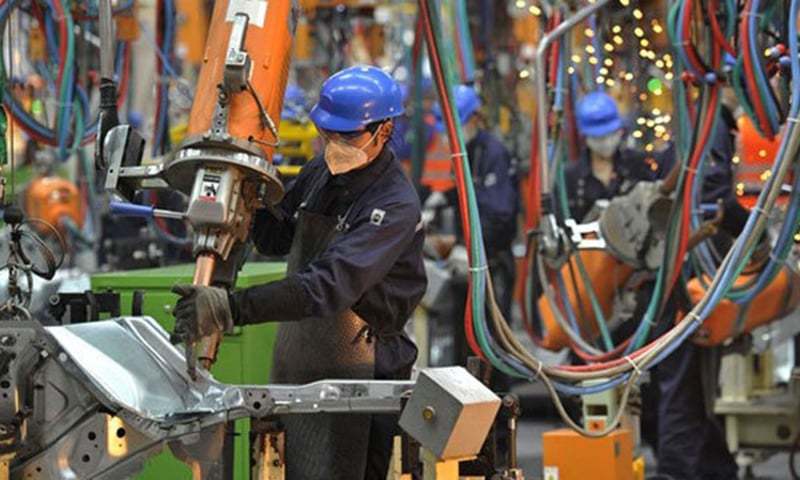Engineering Post Report
In continuation of an insight into three sub-sectors of Manufacturing Sector i.e. Large Scale Manufacturing (LSM), Small Scale Manufacturing (SSM) and Slaughtering, presented last month i. e. November 2021, here is a group wise analysis of LSM during the period of July-March FY 2021 versus July-March FY2020.
!5 LSM groups , performance of which is being reported here, include Textile; Food, Beverages and Tobacco; Pharmaceuticals; Chemicals; Automobiles; Iron and Steel Products; Fertilizers; Electronics; Leather Products; Paper & Board; Engineering Products; Rubber Products; Non-Metallic Mineral Products and Wood Products.
According to the information available from official sources concerned, Textile sector has the highest weight of 20.91 in Quantum Index of Manufacturing (QIM) thus having a significant impact on overall performance of LSM. During the period underreport, textile production had increased by 5.90 per cent during July-March FY2021 against 2.58 per cent decline in the same period previous year. Major jump had originated from woolen segment production . Pandemic of Corona Virus had proved as a blessing of disguise for garments manufacturers as there was a flurry of export orders from European and American markets for Pakistan’s garment sector due to the severe impact of COVID-19 on our regional countries. Cotton yarn production and cotton cloth had also contributed well as they had grown by 3.1 and 3 per cent respectively. The federal government had also facilitated the sector i.e. tax refunds and dury drawbacks, which was bearing fruits and this sector started picking up the pace.
Food Beverages & Tobacco had the highest weight of 12.37 in QIM . This sector had bounced back with 11.73 per cent increase as compared to 1.69 per cent decline previous year. Sugar, cigarette and wheat milling came up with significant growth which boosted the overall sector.
Coke and Petroleum industry production expanded by 12.71 per cent against double digit contraction of 17.54 per cent in the previous year. Production of petrol, furnace oil and diesel grew significantly as demands spurred from resumption of transportation activities accompanied by robust sales of automobiles. Comparatively lower prices of retail fuels during the period also pushed up the petroleum sales by 14 per cent thus encouraging the petroleum production.
In the wake of gas shortages, furnace oil use for electricity generation had increased the fuel’s demand. Besides, Federal Bureau of Revenue (FBR) crackdown against smuggled petroleum products had also led to increase in demand for domestic products. All these factors had thus provided cushion to the otherwise dwindling petroleum industry.
Automobile sector had witnessed a broad-based growth of 23.38 per cent against 37.66 per cent in the previous year. Reduced interest rates, stable exchange rate and huge investments by the new and existing players were having positive impact on this segment as well as enhancing competition .Car production and sale accordingly increased by 20.1 and 31 .5 per cent respectively. Trucks and buses production and sale on the other hand declined by 7.5 and 1.5 per cent respectively. Total tractors production and sale, however, remained promising and recorded as high as 57.5 and 57.1 per cent growth, respectively. Automobile sector was still working below its potential thus offering a lucrative opportunity for manufacturing sector.
Iron and Steel production inched up by 1.66 per cent during July-March FY2021 as compared to 7.96 per cent dip in the same period last year.The federal government had announced multiple incentives for the construction sector which had already started bearing fruits.
Fertilizers production grew by 5.69 per cent as compared to 5.81 per cent growth during last year. The fertilizer subsidies of the federal government had incentivized manufacturers to expand capacity and upgrade plants by offering gas at lower rates. That also attracted investments in this sector and enhanced local urea production capacity. Improved farm economics, lower input costs and better support prices offered by the government had duly supported this industry.
The electronics exhibited lackluster performance and plunged to 20.77 per cent against 15.58 per slump in corresponding period. Electric motors, bearing the highest weight in this segment, had so far been responsible for overall electronics dip. During the period under review, electric motors had dived by 31.8 per cent and dragged down the whole electronics industry. Likewise, electric fans, tv sets and deep freezers also witnessed decline as pandemic had affected the spending patterns and majority was focusing on essentials only.
Non-metallic Mineral Products had surged by 24.31 per cent as compared to 1.87 per cent increase last year. This was mainly driven by 17 per cent jump in cement production. Total cement dispatches during July-March FY2021 had increased to 43.32 million tonnes from 37.03 million tonnes last year.
Engineering products had plunged to 25.53 per cent as compared to 7.28 decline last year. This drag had mainly come from sewing machines and bicycles production which had declined by 43 and 59 per cent respectively.






